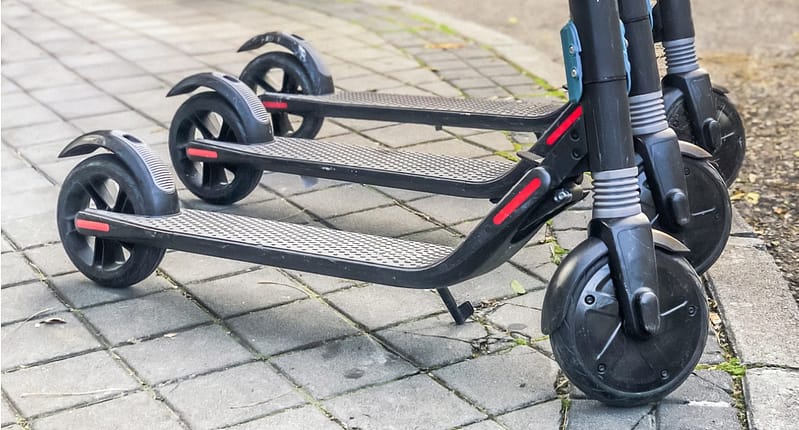Electric scooter sharing initiatives are flourishing in urban areas. The sidewalks and streets of San Francisco, Berlin, Washington DC, Madrid and Tel-Aviv, are packed with parked scooters or riders whizzing by. While the scooters answer an acute need in the pedestrian market – a fast and easy way to get around – the genius of these micro-mobility services lies in their apps and the vehicle data they use to operate.
Data is the key component used to run shared scooters and their apps. Location data is used to assist scooter location, for riding or for charging them. Battery data is used to determine when a scooter needs to be charged and how far its engine will last. If a passenger wants to commence of finish riding? Lock data is used.
Vehicle Data in Action
This automotive data flows between the scooter rider, i.e the customer, and the scooter company, i.e the service provider. But it also flows to a 3rd party, independent scooter chargers, who scan the streets to find scooters that need juice (in exchange for compensation). Thus, riders can find scooters and pay to ride them to get where they need. When the battery dwindles, chargers find them, fill up the battery and put them back on the street in exchange for a payment, where riders can find them once again.
This data-based model ensures a smooth scooting experience – riders know how to easily reach charged scooters and can start riding immediately. This experience would be lacking without the usage of data in the backend of the process: for providing the charged scooters. From the service provider side, the data enables efficient operation in real-time, as well as long-term improvement by analyzing the data over time.
The scooter model is applicable for other means of transportation. The same logic scooter developers implement in their transportation apps, can and should be used by EV app developers as well. By utilizing these insights forthwith, EV and charging station operators can create a pleasant and efficient EV driver experience together with the growth and evolvement of the EV market. For sure, one that is much better than the one the rest of us drivers have in our gas vehicles.
Here are four practices EV app creators can learn from shared scooter apps.
1. Keep Drivers on Top of their Battery Levels
Whether we’re talking about a shared vehicle or an individual one, neither can run on empty. Instead of having to remember the latest battery status or when they last charged, showing the battery level in an app provides drivers with the ability to plan ahead and make time for charging. If they cannot or would rather not charge themselves, they can hire battery charging services.
Battery status attributes that are sent from connected EVs can be used to create this function. App developers should incorporate real-time battery status data into their app and present it to drivers, similar to the way scooters present the battery status. Where should drivers charge? See point number two.
2. Display Charging Options
The shared scooters’ business model is based on individual chargers who recharge the scooters overnight. While this is not a model fit for EVs, the use of data to sustain this model is. The idea behind this model is that when the battery level is lower than a predetermined threshold, a unique data flow and interface are effectuated.
For the EV category, a unique user flow can also pop up based on battery level data. When the EV battery level drops to a certain level, the EV app can show different charging options, like charging at home, locations of fixed charging stations and available mobile charging services. The app can rank different charging options according to price, availability, and personal preferences, while taking into consideration parameters like vehicle location, charging station vacancy and the charging price and time.
3. Leverage Data to Help Both Drivers and Service Providers
Streaming the data from the cars to the drivers opens up a multitude of services for drivers, but it is only part of the puzzle. Similar to the way the scooters operate, battery level status data can also be sent to the chargers: charging station and mobile charging service operators.
Thus, instead of the driver having to look for a charging slot, service providers can offer charging services and promotions that benefit drivers, in real-time based on predetermined categorization. If needed, EVs can also be differentiated according to car type, battery type, etc.
While this data is anonymous, any personal data in this use case would only be used following driver consent and while complying with the strictest privacy and security regulations.
4. Enable Remote Open and Closing
The ability to provide advanced services has to include remote control of the vehicle through data and not just its passive consumption. Remote locking and unlocking of the door, starting the ignition or enabling charging are important abilities that pave the way to mobile charging services and more. Similar to scooters, this function should be based on real-time EV status data that is sent to the driver, and data commands sent back to the vehicle.
Looking Forward
While EV car sharing initiatives still haven’t proven themselves from a business perspective, there is still a lot of EV app developers can learn from a parallel project – shared electric scooters. By incorporating vehicle data into their apps, scooter operators are able to create a successful new category in the market. EV app developers can use car data in a similar way to advance the EV market and deliver new services to drivers. This approach will benefit drivers and app developers alike.
Start developing your own apps with vehicle data. Contact us to learn more.







